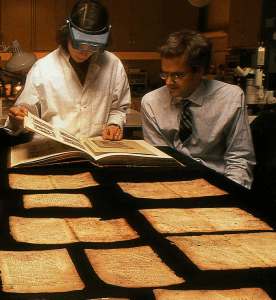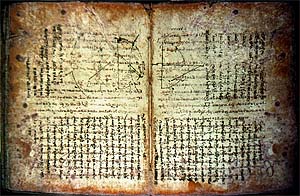.
“The Method” was a work of Archimedes unknown in the Middle Ages, but the importance of which was realized after its discovery. Archimedes pioneered the use of infinitesimals, showing how by dividing a figure in an infinite number of infinitely small parts could be used to determine its area or volume. It was found in the so-called Archimedes Palimpsest (Παλίμψηστος του Αρχιμήδη). The ancient text was found in a rare 10th-century Byzantine Greek manuscript which is probably the oldest and most authentic copy of Archimedes' major works to survive, and contains transcriptions of his writing on geometry and physics. The 174 pages of text was according to the Greek orthodox church stolen but the owners were descendants of a Frenchman who legally bought the volume in the 1920s. It was sold for $2 million at Christie's.


Analysis and restoration of the Palimpsest in Baltimore (a work expected to be complete in 2007), right image Abigail Quandt and William Noel (Photos from Steinmetz George Copyright GEO EPOCHE No. 13 Journal)
The manuscript was the only source for his treatise “On The Method of Mathematical Theorems” and the only known copy of the original Greek text of his work, “On Floating Bodies”. The manuscript also contains the text of his works “On The Measurement of the Circle”, “On the Sphere and the Cylinder”, “On Spiral Lines” and “On the Equilibrium of Planes”.
The volume is a palimpsest, a manuscript in which pages have been written on twice. As writing material was expensive an original text could be washed off so the parchment could be reused. The upper layer of writing on the document to be auctioned contains instructions for religious rites but underneath it contains versions of Archimedes' most celebrated Greek texts. In the Middle Ages, the work was owned by a monastery in Palestine whose collection was incorporated into the Greek Patriarchate library in Jerusalem in the 19th century. It was later transferred to a monastery in Istanbul. The work was taken to Athens when the monastery's library was broken up after World War I.
The original text was likely erased in the 12th or early 13th century when the parchment was reused to make a Greek prayerbook. It was rediscovered in the Convent of the Holy Grave in Constantinople in 1907. Danish scholar Johan Ludvig Heiberg first copied the Archimedes text which appears as faint lines of light brown ink underneath darker brown ink using only a magnifying glass and natural light.

Experts of Christie's were able to enhance several pages using ultraviolet light and digital scanning. There are real possibilities for making additional recoveries, for making discoveries that Heiberg was unable to make because he couldn't see them. Among these are complex geometric diagrams that Heiberg couldn't read but reconstructed from his own understanding of Archimedes' theories.
New techniques for reading the faint traces of the older text have accentuated its enormous importance. Pages exposed to ultraviolet radiation causes the vellum, which is preserved animal skin, to glow, improving the legibility of the writing. The experts digitized images of the writing and applied a computer program to suppress the 13th-century text and religious illustrations while enhancing the underlying writing and geometrical diagrams. The later religious text was written at right angles to the Archimedes text, a fact that facilitated the separation of the two texts.
Mathematicians and historians of science have been visiting Christie's recently to look at the treasure. "Just seeing and touching the Archimedes Palimpsest was a thrilling emotional experience for me," said Dr. Sherman Stein, a professor of mathematics at the University of California, Davis.
The discoverer, Dr. Johan Ludvig Heiberg, a professor of philology at the University of Copenhagen, was not permitted by Turkish authorities to remove the manuscript, but he was allowed to copy it the best he could, and he later translated the legible parts. Heiberg got another look at the manuscript two years later -- the last scholarly inspection of the treasure. In 1918, the Ottoman Empire was dissolved by Turkey's defeat in World War I, and book collections in Constantinople were broken up. A Christie's manuscript expert, Dr. Felix de Maraz Oyens, said in an interview that some time after 1920, the palimpsest passed into the hands of a French family that has owned it ever since. Christie's declines to identify the family, which has put the document up for auction.
From the time of Heiberg's investigations in the early 20th century until the document was entrusted to Christie's, it had never been examined by anything more sophisticated than a magnifying glass. Dr. Hope Mayo, a consultant to Christie's on ancient books, said that the auction house enhanced only a few pages of the palimpsest to show what could be done. A more thorough inspection will be the responsibility of its future owner, she said, although the book may be bought by someone unwilling to grant access to scholars.
"That would be a terrible loss," said Dr. Chris Rorres, a mathematics professor at Drexel University and an amateur Archimedes scholar.
"The rigorous mathematical proofs devised by Archimedes have come down to us from various sources, but only his 'Method of Mechanical Theorems,' recorded in this palimpsest alone, lets us see how he arrived at his proofs. It is a bit like a structure in which the scaffolding goes up first, then the building, and finally the scaffolding is taken away, leaving only the final result. Archimedes' “Method” is the only remnant of his work that lets us see the scaffolding," Rorres said. The Archimedes "method" starts by experimenting with physical objects and then looking for the abstract principles that underlie their interactions. In the Introduction Archimedes wrote: "It is easier to supply the proof when we have previously acquired, by the method, some knowledge of the questions than it is to find it without any previous knowledge."
Recently reading the palimpsest, a copy of Archimedes' treatise The Method of Mechanical Theorems, Prof. Netz and Japanese colleague Ken Saito found that the Greek mathematician had compared two infinitely large sets and noted that they had an equal number of members. No other surviving Greek mathematics text does that. Mr. Netz considers this as the most important manuscript associated with Archimedes.
Byzantium, the successor of the East Roman Empire, was the custodian of the Archimedes Palimpsest for centuries until it was somehow obtained by a French around 1920 and its family sold it at Christie's to some unknown almost 80 years later. In 1998, an anonymous billionaire bought it for $2 million and lent it to the Walters Art Museum in Baltimore, where it still resides.
See also
Archimedes Method, a page commemorating the exhibition and sale of the Archimedes Palimpsest
- Archimedes Mathematics
- Archimedes cubic and bi-quadratic equations and a method for angle trisection
- Archimedes and Combinatorial Problems (The loculus of Archimedes)
- Archimedes the Arbelos and the Salinon
- Archimedes semi-regular Convex Solids
LINKS
- Eureka! The Archimedes Palimpsest
- Simulating Digital Image Processing used for the Archimedes Palimpsest
- The Origins of Mathematical Physics: New Light on an Old Question from AIP
- Palimpsest Teaches History, Geography
- Palimpsest and Astronomy
References
- The Works of Archimedes: Translation and Commentary, Vol. 1 Reviel Netz, Cambridge University Press 2004
- Geometrical Solutions Derived from Mechanics, A Treatise of Archimedes, Recently discovered and translated from the Greek by Dr. J. L. Heiberg PDF File
- The Works of Archimedes , Thomas Little Heath, Dover Publications, Incorporated 2002
Greek Quotations
Χωρίς περιστροφάς, είναι γνωστόν και σήμερον που αποκρύπτονται σημαντικότατα αρχαία κείμενα. Κατά τον τρόπον που οι διάφοροι ξένοι, άτομα, κράτη, κατέκλεψαν τα απαράμιλλα έργα της Αρχαίας Ελληνικής Τέχνης, που κοσμούν τα Μουσεία των, κατά τον αυτόν τρόπον απέκτησαν και αποκρύπτουν ορισμένοι ξένοι και πολλά αρχαία κείμενα, η έκδοσις των όποιων θα απεδείκνυε ότι οι αρχαίοι "Ελληνες σοφοί εγνώριζον πολύ περισσότερα από εκείνα πού έχουν διασωθή και έχουν έλθει μέχρι σήμερον εις τη δημοσιότητα Το 'Αρχαίον Έλληνικόν Πνεύμα
| Ancient Greece
Science, Technology , Medicine , Warfare, , Biographies , Life , Cities/Places/Maps , Arts , Literature , Philosophy ,Olympics, Mythology , History , Images Medieval Greece / Byzantine Empire Science, Technology, Arts, , Warfare , Literature, Biographies, Icons, History Modern Greece Cities, Islands, Regions, Fauna/Flora ,Biographies , History , Warfare, Science/Technology, Literature, Music , Arts , Film/Actors , Sport , Fashion --- |

